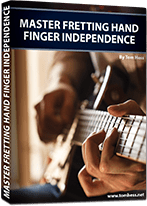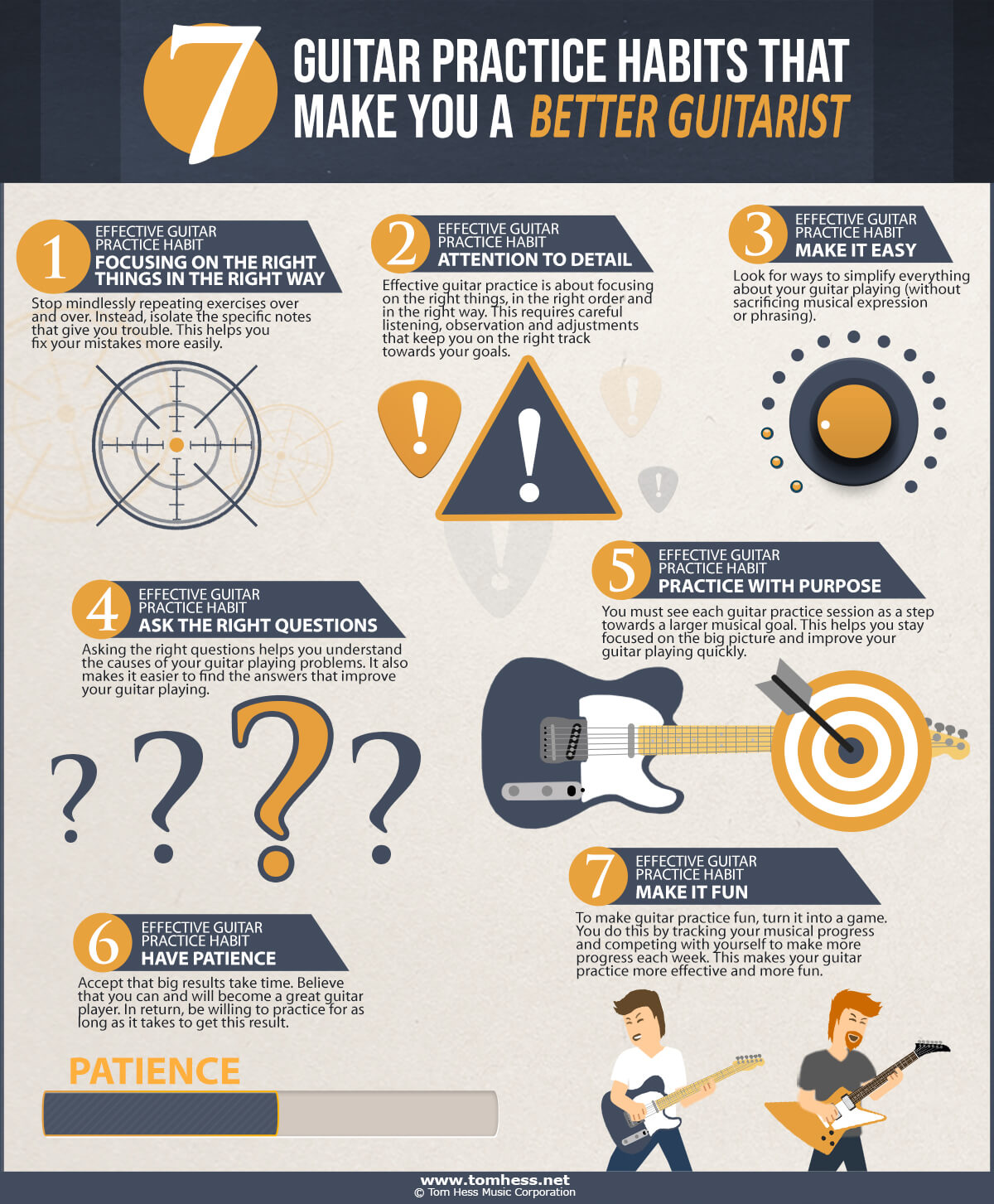The Best Guitar Practice Method To Use To Improve Your Guitar Playing Fast
Feel Incredibly Easy

EMAIL TO GET ACCESS
By submitting your info, you agree to send it to Tom Hess Music Corporation who will process and use it according to their privacy policy.
Is it REALLY possible to improve your guitar playing and become a better guitarist without practicing guitar 8 hours per day?
Answer:
Yes, but...
You’ve got to have the right guitar practice methods, proper guitar practice habits and a proven guitar practice routines to get there.
Don’t worry though...
In this article, I’ll show you many such guitar practice methods.
Feel Incredibly Easy

EMAIL TO GET ACCESS
By submitting your info, you agree to send it to Tom Hess Music Corporation who will process and use it according to their privacy policy.
Along with the guitar practice habits (and guitar practice routines) that I and my top guitar students use to play guitar like pros, despite practicing (often) less than 1 hour per day.
Just follow along and get ready to become a better guitarist faster and easier than you ever thought you could.
To begin...
Watch this video on how to develop champion-level guitar practice habits that make you better quickly:
Now that you know about the best guitar practice habits pro players use, here are a few more guitar practice tips that improve your guitar playing quickly and make practicing guitar fun:
Effective Guitar Practice Habits Example #1: Set Micro Goals
You probably know that there are different types of goals you can base your guitar practice routines around when you want to improve your guitar playing:
- Long-term goals (the ones you plan to reach and become a better guitarist from in 1 year or more).
- Medium-term goals (the ones you plan to reach in 6 months to 1 year).
- Short-term goals (the ones you plan to reach in less than 6 months).
All these goals are great to have (and base your guitar practice routine around). And if you set these goals correctly, it becomes much easier to develop great guitar practice habits.
But then there are the things I call: “micro goals”.
These are concrete and specific objectives you plan to reach in a single guitar practice routine.
Here is how to incorporate them into your guitar practice method (and day-to-day guitar practice routines):
- Choose a (big) area of playing you want to improve. (Say weep picking, for example).
- Choose something very specific you can focus on about your sweep picking that will make you better at it. For example: finger rolling.
- Decide what exactly you’re going to do to improve finger rolling to become a better guitarist today.
And determine how you’ll know if your finger rolling has improved or not by the time you’re done practicing today.
(This clarity alone is a powerful guitar practice method that helps you become a better guitarist a lot faster.)
Here are some micro goal examples when it comes to improving finger rolling:
Simply review the mechanics of finger rolling until you know them cold and can speak them out loud, if needed. (That is something you can achieve in 1 practice session and it’s nearly guaranteed to improve your guitar playing that very same day.)
Watch this video to see what I mean by “reviewing the mechanics of finger rolling”:
Another example of a micro goal could be doing a certain finger rolling exercise, trying to play it 1-2 bpm faster than you could in your previous guitar practice routine.
(The ‘1-2 bpm’ objective is a small-enough micro goal that you are certain to reach it the very day you set it.).
Or, it could be focusing on the sound of one note at a time to make sure it is clean. (This is an example of a guitar practice method called focus rotation. More on that guitar practice method below.)
These micro goal variations help install the right guitar practice habits that help you become a better guitarist quickly.
Effective Guitar Practice Habits Example #2: Have A Problem-Solving Mindset
Whatever guitar practice method you use, it had better be based around a problem-solving mindset.
Why?
Because the main point of any guitar practice method (or guitar practice routine that can help improve your guitar playing) is to help you ‘solve problems’ in your guitar playing.
So, what exactly is a problem-solving mindset and how do you develop the right guitar practice habits that reflect it?
Here is an example of a guitar practice method that shows the problem-solving mindset in action:
Let’s break down the principles that make this guitar practice method so effective (understanding these principles helps you develop the guitar practice habits that improve your guitar playing fast).
1: Focusing On The Right Things In The Right Way.
In the video above, you could see how I got my student to stop repeating exercises over and ‘mindlessly’. Instead, I trained him to isolate the specific notes that were giving him trouble. This helped him fix his mistakes more easily.
 14 Day Guitar Speed Mini Course
14 Day Guitar Speed Mini CourseDiscover the most effective ways
to quickly build your guitar speed.
 Free Guitar Speed Secrets Video
Free Guitar Speed Secrets VideoLearn the speed building secrets
that most guitarists don't know.
 Strengthen Your Guitar Technique
Strengthen Your Guitar TechniqueDiscover how to play with cleaner,
more accurate guitar technique.
2: Attention To Detail
Effective guitar practice habits help you to carefully listen to your playing, observe what is (and isn’t) happening and adjust what your hands are doing to stay on the right track to become a better guitarist.
3: Make It Easy
The best guitar practice habits (and guitar practice routines) help you simplify what you are playing (without sacrificing musical expression and phrasing).
4: Ask The Right Questions
You saw me do a lot of that with my guitar student, as I asked him questions that guided him towards the answers and helped him become a better guitarist within just a few minutes.
5: Practice With Purpose
Each guitar practice session should be a step that guides you towards a larger musical goal. This helps you stay focused on the big picture and become a better guitarist most quickly.
6. Have Patience
Even with fast-acting guitar practice habits (like setting micro goals for your guitar practice routine), reaching big goals will take time. That said, if you believe that you can and will become a great guitar player – doing the work becomes easier.
7. Make It Fun
The best guitar practice routines (the ones that actually improve your guitar playing quickly) turn guitar practice into a fun game. It’s a game where you compete with yourself as you track your musical progress each week.

Effective Guitar Practice Habits Example #3: Use Focus Rotation
This guitar practice method is like the Swiss Army Knife of all guitar practice habits (and it should be part of your guitar practice routine, no matter what your goals are).
How does focus rotation work and how does it help you become a better guitarist?
Simple:
Say you are about to practice a guitar technique exercise (for example: a scale sequence).
You probably have a number of things to focus on to get better at playing that scale sequence that would help you become a better guitarist and that you ‘could’ add to your practice routine.
Everything from:
- picking hand technique (and all of its many elements)
- fretting hand technique (and all of its many elements)
- 2-hand synchronization
- timing (yes, lead guitar timing. It’s one of those key guitar practice habits so many guitarists ignore).
- string noise control.
- creativity
- fretboard visualization
... and that’s just off the top of my head.
There is no way to cram all of those things into a typical guitar practice routine, right?
Except when you are using the ‘focus rotation’ guitar practice method, there is. (And that is what enables you to become a better guitarist and improve your guitar playing much faster.)
All you do is repeat your scale sequence over and over for say – 15 minutes. But during those 15 minutes, you rotate your focus from one element of your playing to the next.
Rotate your focus every 1 minute or so. And as a result, you will cover all 15 elements that (in any conventional guitar practice method that doesn't use focus rotation) would normally take you weeks to go through.
You can also structure your guitar practice routine to use focus rotation like this:
Focus on one note in a fast guitar lick you are playing and (temporarily) ignore all the others.
Keep listening for that note until you are certain it is clean. Then, rotate your focus to the next note in the lick (ignoring the others – including the note you were just focused on a moment ago).
Refine the sound of that new note.
Keep rotating your focus this way until you’ve cleaned up the entire guitar licks, without even slowing it down!
Here is an example of this guitar practice method (with a more in-depth explanation of the guitar practice habits it requires).
Question: “But Tom Hess, isn’t it better to focus on one element of your guitar playing for a long time instead of rotating your focus from one thing to the next every few minutes? Isn’t the former – the better guitar practice method if you want to improve your guitar playing and become a better guitarist?”
Answer: No. This is an example of something known as a ‘linear’ guitar practice method. And I believe that the guitar practice habits it creates lead to slower progress.
The main reason is: it’s impossible to do anything with ‘one’ musical skill. You have to develop as many musical skills as possible at the same time. (I call this: improving ‘geometrically’.) This enables you to integrate your musical skills together and feel like a musician instead of just a guitar player.
What I just told you is one of the most powerful guitar practice methods that can improve your guitar playing lightning fast.
Effective Guitar Practice Habits Example #4: Exaggerate The Difficulty
One of the least-known (but highly effective) guitar practice habits for undoing deeply-rooted bad habits in your technique is...
(Briefly) making them worse than they are.
For example:
Have tension in your shoulders? Tense the shoulders up even more (for a few seconds) and relax them.
Struggling to pick from your wrist (and using the thumb and index fingers to move the pick instead)? Move them even more and intentionally stiffen the wrist for about 20 seconds. Then try using the wrist again.
Struggling to play in time with the metronome? Intentionally make your timing worse for about a minute. Then, locking in with the click will feel easier. Much easier.
All this shocks your brain and hands and reminds you just how bad the old guitar practice habits are feeling – making it easier to make the new guitar practice habits stick... and improve your guitar playing much faster.
Use this guitar practice method when simply ‘slowing down’ isn’t working.
But make sure to still do plenty of slow practice as part of your ‘undoing bad guitar practice habits’ guitar practice routine.
Watch this video to see what I mean:
Effective Guitar Practice Habits Example #5: Use The Metronome To ‘Test’ Guitar Speed, Not To ‘Build’ It.
This may sound crazy, but your metronome doesn't actually build guitar speed – it only tests it.
Here is what I mean:
Guitar speed is a byproduct of lots of individual guitar playing elements. Things like:
- Technique (motions)
- Synchronization
- Tension control
- String noise control
... and many others.
To develop each one, you need to know:
1. Which guitar speed elements you’re lacking right now.
2. Correct guitar practice methods (and guitar practice habits) for installing the missing elements into your playing.
Well, guess what?
To train them, you’ll often need to practice so slowly, the metronome click will be a distraction.
Plus, the metronome can create a temptation to speed up before you are ready.
Thus, it’s almost always best to train the guitar speed elements (that ‘actually’ make you faster) away from the metronome.
And then, use the metronome to ‘test’ just how far your speed has improved.
Sounds simple, right?
It is. But this ‘simple’ mindset can go a long way towards helping you build guitar speed and become a better guitarist a lot faster.
Now you know what guitar practice method(s) help you become a better guitarist, it’s time to transform the rest of your guitar playing (everything from your guitar technique to music knowledge, creativity, lead guitar soloing and more).
I can help you with that in my personalized Breakthrough Guitar Lessons.
Here is how it works:
You tell me everything about your guitar playing strengths, weaknesses, musical background, and musical goals. I then create your personalized guitar lesson strategy. As you practice your lessons, I give you a ton of feedback to help you master your guitar lessons and reach your musical goals.
To begin, click the green “Start Now” button below.

Become a better guitar player with proven rock guitar lessons online.

